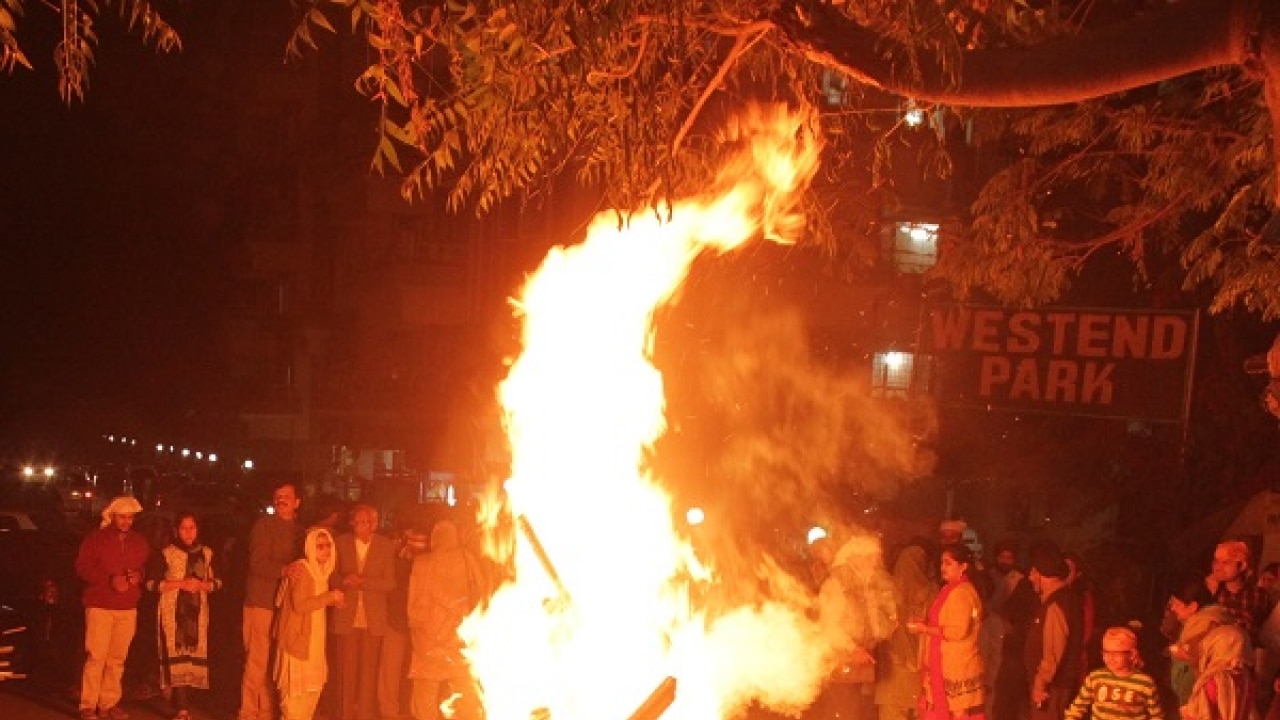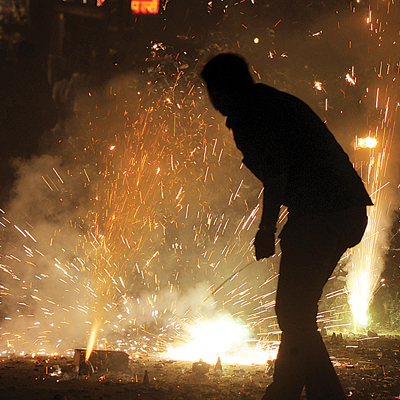
Fire occurs when chemicals react in a manner that releases heat and visible light. It is as simple as that. Yet fire is such a complicated agency in our life that it boggles our imagination. Scientific evidence suggests that humans learned to control fire about 800,000 years ago. Since then we have used fire to cook, to scare animals and to produce light where needed. We have learnt to control it and make it mobile. Petroleum and its products have allowed us to control fire and ignition in an unprecedented manner. Internal combustion engines that run everything from cars, trains and early aeroplanes is the ultimate demonstration of our ability to control fire. A small spark burns the inflammable mixture of fuel and oxygen in the chamber of internal combustion engine for a fraction of a second and produce hot gases that drive a whole host of motions.
Fire is an extremely complex entity. To make the point, I am reproducing below, some of the pictures of an equivalent of Amar Jawan Jyoti in Bishkek, capital of Kyrgyzstan.

The Eternal Flame at the Victory Monument in Bishkek, Kyrgyzstan
This fire is fed continuously by an underground gas line. The gas comes out at a low pressure and mixes with cool air of an open area. If the gas catches fire quickly, it rises as a single large flame of hot gases. On the other hand if the surrounding interferes with the gas that is coming out, the flames can disintegrate into many distinct blobs, each hot with burning fuel and yet separated from other cool blobs. The fire won’t extend into the tube because, oxygen, that is vital for burning is not available inside the tube! Same environment, same gases, same temperature, but subtle differences in the rising gases means completely different looking fire! If you are an engineer you will appreciate that these little flames that solve a whole set of extremely complex mathematical equations, instantaneously, in real time and in practical, finite element method to give you flames. To simulate this would require supercomputers or cloud computers of considerable power.
Compare these flames for example, with the flame of cooking gas either from a kerosene stove or cooking gas. Here the gas flames are completely dominated by the pressure of the gas coming out and the hot neighbouring environment, fed by oxygen from the air coming from the central hole in the burner. The flame has the same steady flame on which one can cook. It is also more efficient in converting fuel to heat, minimising waste and doing a quick job of cooking the food.
Candles on the other hand, with their wicks that work like inflammable little capillary tubes are a marvel of a completely different kind. Candles are made from inflammable wax which is solid at room temperature but easily melted. So when you light the candle, you use that heat not only to maintain high temperatures—something that all flames do—but also to melt the fuel and suck it up the wick to evaporate and burn. In the process, they produce a flame whose characteristics are unique. The hottest part of a candle flame is at its top, you look at the candle, farthest from the tip of the wick. Oil lamps also do the same thing, except that their fuel is already in the liquid form.
We Indians perform all kinds of fire worship and many use a particular compound called camphor. If you look at camphor burning, it is fundamentally different from candle burning. Camphor sublimates a whole lot of inflammable material nearly instantaneously and the surrounding air is incapable of supplying oxygen at that rate. Hence a lot of fuel remains unburnt, rises slowly in the air and then falls back as soot. This soot is one of the most amazing materials in the universe. Even aircrafts are made from such materials. In the absence of oxygen the carbon of camphor rises into the air and when it does find oxygen, it is too cold to burn. So it gathers itself with other carbon atoms to make black soot. But because the material has so much relaxed and un-pressured time, the soot can consist of individual units of several hundred carbon atoms. These large molecular chains of carbon, when combined, can be as tough as steel and as light as a feather. They are called carbon composites and are used to manufacture aircraft wings, for example.
Fire is all destructive and all constructing. It changes. Fire is the agent of choice in ancient India and offerings to gods were given to fire for delivery. Fire was our ancient and instantaneous courier service. In ancient Indian literature, three kinds of fires were identified— fire that purifies our sacrifices to gods and delivers it to them, fire we use for domestic use and fire that we use to light the pyre of the dead. In the 21st century we may want to add industrial fire and fire without flames as two more categories of fire. When you think about it, all these forms of fires do look completely different.
From initially using fire to bake vessels, industrial fires have reached temperatures of 5000 degree Celsius that can melt iron and we now want to reach temperatures of millions of degrees that can fuse hydrogen into helium and give us even more energy. The fires without flames come from two sources, one is electricity and the other is radioactive material. They both produce heat and can burn things but they do not have a flame of their own.
Fire is one of the five basic elements of the universe according to the first textbook of physics, Vaiseshika written in 600 BC. It is a fundamental entity that exists and can mix with other substances and change their properties.
But the most fascinating aspect of fire is as a religious symbol. For Hindus, it has an ability to convey our offerings to the Gods. Parsis worship fire as a symbol of God himself and many other religions hold fire as a witness to things in view of its incorruptibility and an ability to hold its own against anything thrown at it. Its visual brilliance also has a charm of its own and its ability to provide heat and change properties of matter is also very impressive. For this reason, the Sun is also considered an agent of fire.

Then there are fires for celebration. When Olympics are announced it is a flame that is carried around. Flame, to light many a heart and enthuse people into participating in the upcoming event. But fire crackers are a more common example. These are devices filled with highly inflammable material which, once lighted, will ignite into an explosion. To achieve this, the manufacturers put both, the (dry) fuel and something to release oxygen when heated (oxidizers), together into one unit so that material explodes suddenly. To this explosive mixture various compounds are added to produce the colourful effects. Wikipedia entry on Pyrotechnic composition lists out more than 50 different compounds that can be added to the firecracker to obtain the desired colour or visual effect. These fires burn instantaneously to 3000 degrees. However, if you have stood next to one of these, you rarely get burnt because each piece of sparkle, though hot, is so small that it contains very little heat. So it is hot for a few seconds but does not carry enough heat to burn anything. You have to either take the blast of a firecracker (the usual cause for injury) or a large amount of burning firecracker material has to fall on you to injure you.
Truly fire is a strange and mystical agency. Lighting some fires is fun, some others like cigarettes are injurious to our health and large uncontrolled fires (a weapon of choice in human wars as well as nature’s wars against human intrusion) are the stuff of nightmares. Humans love fire and use it all the time, yet we all like to have an insurance against it.